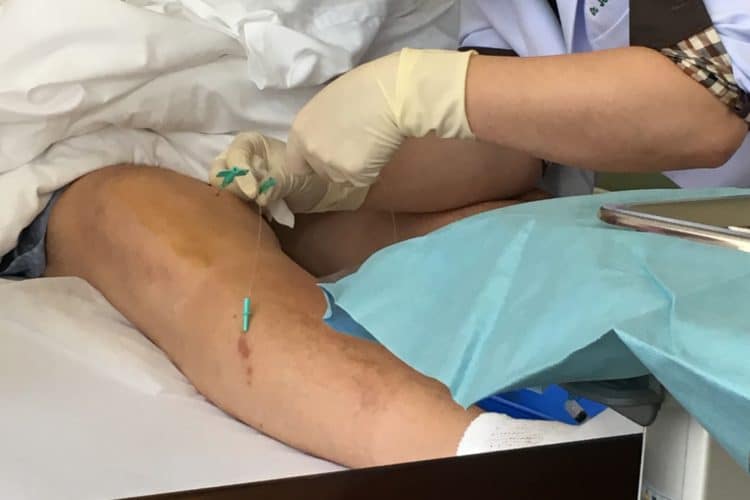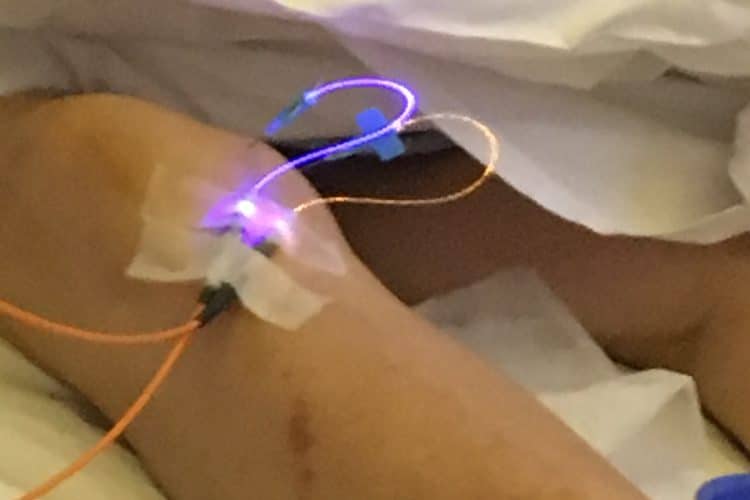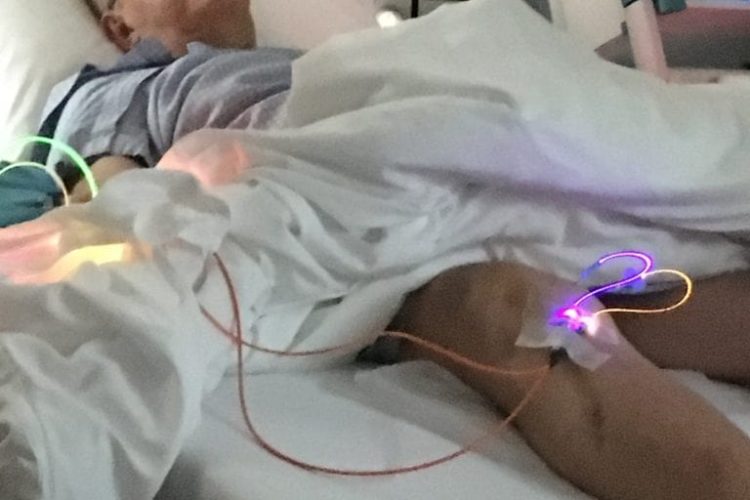Knee Pain can often be caused by: overuse, sudden injury or an underlying condition. Common degenerative conditions, such as osteoarthritis may drastically affect the knees, especially with age. Depending on the cause, severity or the condition, there are a host of possible treatments. The symptoms of knee pain include swelling, redness, and stiffness.
Until recently, knee surgery had been the only option for sufferers. Surgery may be the only option. However many patients have used adult stem cells, PRP or umbilical cord stem cells to avoid surgery and lessen their pain.
Inflammation
Injuries produce inflammation that occurs where soft tissue, such as ligaments and tendons attaches to bone. Inflammation is simply the result of injury caused by mechanics or formation of bone spurs (osteophytes) or extra fluids in the knee. Swelling may be more pronounced after longer periods of inactivity.
Knee pain makes everyday activities, such as walking or climbing stairs quite difficult. It is a common orthopedic site for chronic tissue degeneration that results in moderate to severe pain. With knee pain one may experience stiffness, swelling and often may find it difficult even to bend the knee to perform tasks. Unfortunately, this is why one may eventually resort to traditional surgery. Surgeries typically involve partial or total knee replacements.
Bangkok Stem Cells offers various orthopedic regenerative therapies that use the body’s natural inflammatory process to reduce inflammation and the pain using non-surgical options that are safe and clinically proven to be effective for many patients. Sometimes knee surgery is a necessary option, but these therapies can also be used in conjunction to accelerate healing and lessen scaring.
Ligament Injury
Ligaments connect thigh bones to lower leg bones while holding your bones in place and stabilizing the knee. Ligament damage (sprains and tears) are very often a result of sports injuries. Any of these injuries may result in severe knee pain with physicians recommending surgery.
Medial collateral ligament (MCL) helps to protect and stabilize the knee joint against any blows or forces that may be directed on to the outer side of the knee. It helps to limit the amount that the knee moves from side to side.
Lateral collateral ligament (LCL) helps to protect and stabilize the knee joint against any blows or forces that may be directed on to the inner side of the knee. This ligament also helps to limit the amount the knee moves from side to side.
Anterior cruciate ligament (ACL) helps to stabilize the knee joint by controlling backward and forward movements of the knee. It stops the tibia bone from moving forwards in front of the femur.
Posterior cruciate ligament (PCL) helps to control the forward and backward movements of the knee.
Arthritis
Knee arthritis makes everyday activities, such as walking or climbing stairs quite difficult. It is a common chronic degenerative condition that cause moderate to severe pain. With arthritis one may experience stiffness, swelling and often may find it difficult even to bend the knee to perform tasks. Unfortunately, this is why one with arthritis may eventually resort to traditional surgery. Surgeries typically involve partial or total knee replacements. A 2015 study by Harvard University of 12,000 patients found an 800% increase in heart attack one month after knee replacement surgery.
The most common type of knee arthritis is osteoarthritis which is a progressive wearing of cartilage at the knee joint. Frequently after the age of 50, the age-related affects of osteoarthritis worsen causing continued overuse and wearing down of connective cartilage.
As with most orthopedic degenerative conditions symptoms become worse as the condition progresses. Common treatments include: weight loss, strengthening exercises, wrapping, and pain relievers such as acetaminophen and non-steroidal anti-inflammatory drugs (NSAIDs).
Bangkok Stem Cells cell-based therapies have helped and offered relief too many patients who suffered from knee osteoarthritis and help them avoid a painful knee replacement.
Although there is no cure for arthritis of the knee, there are many treatment options available to help manage pain and keep people staying active. Many patients have opted for adult stem cells, PRP or umbilical cord stem cells to avoid questionable surgeries and reduce their pain.
USE OF STEM CELLS FOR KNEE CONDITIONS
Stem cell therapy is claimed as a miracle cure for everything from wrinkles to spinal repair throughout the world. Although very few of these applications are scientifically supported, stem cell therapy for knees has been the topic of several successful research.
When the cartilage lining the joints begins to deteriorate, arthritis develops, causing pain and restricting function. Osteoarthritis is widespread. Arthritis and similar diseases in the world are a significant cause of disability.
Approximately 600,000 people get a knee replacement each year, a number that could increase to 3 million by 2030. Treatment alternatives have been either temporary or surgical until recently.
Now, stem cell therapy for knees reduces pain and repairs cartilage in countless instances. As a consequence, many individuals were able to enhance their quality of life and prevent surgery.
Adult stem cells are responsible for maintaining and healing tissues by replenishing damaged and dying cells. Blood supply is restricted in certain regions of the body, such as the knee, so stem cells do not operate as well as they should.
Alternatively, however, they may be injected at which point the self-recovery method appears to be initiated.
Knee osteoarthritis (KOA) is a complicated disorder to treat and manage and can be resistant to drugs, operations, and even surgery. Due to obesity or comorbidity, surgery may not be an alternative for some patients. The therapy of KOA is very promising in regenerative medicine using stem cells, platelet-rich plasma (PRP), amniotic fluid, and cytokine modulation.
What are stem cells?
These are extraordinary types of cells with the capacity to multiply and self-renew. They also have the power to replicate into specialized cell types forming potentially any tissues in the body.
Stem cell for knees treatment
Joint cartilage’s usual task is to encourage smooth joint surface motion and safeguard bones from friction. This method enables shock absorption up to 20 times the body weight. It is crucial to physical movement, particularly in athletics.
Scientists wanted to understand if mesenchymal stromal cells (MSCs) could be used to regenerate knee cartilage. These cells can grow into various kinds of cells, including muscle, bone, and, most importantly, cartilage.
Knee stem cell therapy is significantly invasive. It is an operation that can reduce inflammation, slow and repair all these types of harms of arthritis, and delay or prevent surgery for replacing the knee.
Stem cell knee injections
Simple techniques can be used to extract adult stem cells from bone marrow or fat. Then, with picture instruction, it is focused and injected into the knee, generally for good outcomes.
According to researchers, it is believed that stem cell therapy for knee works by
- Developing into essential cartilage cells
- Thwarting the inflammation that can worsen arthritis
- Releasing proteins called cytokines that slow degeneration of cartilage and reduce pain
Side effects
Knee stem cell therapy is non-invasive and rarely painful. There are minimal side effects. Mild pain at the injection site, inflammation, and some joint stiffness are the most common experiences after the operation.
Stem cell knee repair cost
A study of various medical organizations shows pricing varies greatly depending on the severity and quality of cells used for the knee for stem cell therapy. Our package for 50 million passage one, umbilical cord stem cells with a complete 5-7 treatment program starts at 19,800 USD. It includes 2-3 hours of treatment each day and all supplemental therapies to boost and enhance the regenerative treatment for knee pain and cartilage loss.
Most insurance companies are not yet covering stem cell injections, but this may begin to alter as more study accumulates demonstrating the process’s efficacy.
In one visit, people typically finish the operation, but they generally have an original consultation and a follow-up appointment. It takes about two to three hours for the injections.





